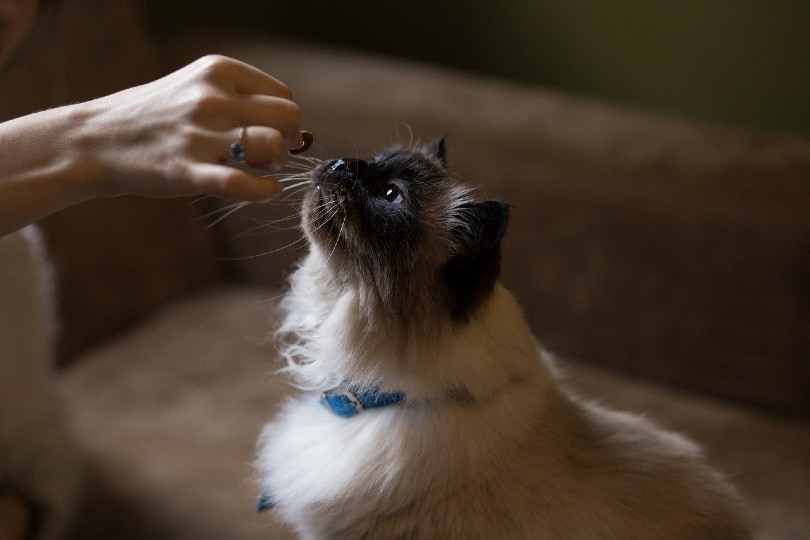How to Teach a Cat Their Name in 7 Simple Steps

Updated on

Cats are intelligent animals, but they don’t respond to praise in the same way dogs do. This means that while cats can learn their names and may respond to them, you will need to find some reward other than affection to assist in your positive reinforcement efforts. Food and treats are commonly used because most cats are driven by their stomachs. However, cats are independent, and they know their own minds. Some may choose to respond to their name whenever it is called, and others may choose to ignore you.
Below are 7 steps to help you teach a cat their name, as well as some information on how to choose the right name for your new feline friend.
Choosing a Name
Choosing the right name for your cat is important. It needs to be short, snappy, and a name that you will consistently use.
- The name should be simple and easy to repeat. Cats can learn long names, but the longer the name is, the more likely you will shorten it and use different derivatives, which can cause confusion and will prevent even the most determined cat from responding. Try to stick to a one or two-syllable name.
- Avoid using names that are similar to other pets and even family members. It will cause confusion if you have a cat named Stitch and a dog named Mitch. They will both be likely to respond to the other’s name.
- Choose something that the whole family will use and that you will be comfortable shouting at the door when it’s time for your cat to come home. Using offensive or awkward names means that you or somebody else in the house will use an alternative name and your cat will be less likely to respond every time.

How to Teach a Cat Their Name
Now that you’ve chosen a name, it’s time to start teaching it to your cat. The key to any training is consistency, and you should be prepared for the fact that while some cats will instinctively learn their name in just a couple of days, others can take weeks. Some cats may never respond to their name, even if they know what you want from them.
The 7 Simple Steps to Teach a Cat Their Name
1. Choose a Reward
Dogs respond to love and affection—cats, less so. For most cats, the ideal reward is a tasty treat. Determine your cat’s favorite morsel of food and use this as your training reward. Make sure the treat is a healthy snack that you have plenty of in the house. Also, ensure that you adjust your cat’s daily food intake according to the number of treats you give.
2. Say Your Cat’s Name
Sit or stand within a few feet of your cat and say their name. Use a warm and affectionate tone and be prepared to repeat the name a few times before they turn and look at you.
3. Reward Them for an Appropriate Response
If they look at you, quickly give them a treat. Cats don’t have the longest attention span, so if you wait too long to give the treat, they won’t associate it with their name. You can put the treat on the floor in front of you. This can help them turn to you when you do use their name.

4. Repeat
Repeat the process a few times in the same situation. Give your cat a treat each time they respond to their name. Early training sessions should only last a few minutes. This prevents your cat from getting bored and also means that you don’t overfeed them with treats. Train for a few minutes every day.
5. Move Away
Once your cat consistently turns to you when you call their name, you should move further away from your cat for your next training session. Move to the other end of the room so that they can still see you. Repeat the process of calling their name and giving a reward when they respond. Eventually, you can move to another room and continue with the process.
6. Alternate Your Treats
As you progress with training, you should introduce new and different treats. If your cat enjoys being petted, you can stroke them sometimes rather than giving a food treat every time. If they enjoy playing with toys, throw their favorite toy mouse to them.

7. Reduce Treats
You don’t want to have to give a treat every single time your cat responds to its name for the years to come. So, once your feline companion gets the hang of training, reduce the frequency at which you give treats. At first, just skip one treat every four or five times. Then, only give a treat every other time your cat responds, and then once every three or four times. Eventually, you should only give a treat occasionally. You will need to give occasional treats just to reinforce the behavior and to ensure that they do keep responding.
Final Thoughts
Training a cat can seem an impossible task. Rarely are our feline companions as motivated to please us as our canine companions are, but they can be motivated through the use of tasty treats and their favorite toys.
Name recognition is the most important first step in training, and it is one that will encourage your cat to come indoors at night and for a host of other reasons. Using the 7 steps above, you will have a much greater chance of teaching your cat their name than if you were to leave it to chance, but some cats will never reliably respond to their names no matter how well you train them.
Featured Image Credit: izmargad, Shutterstock











